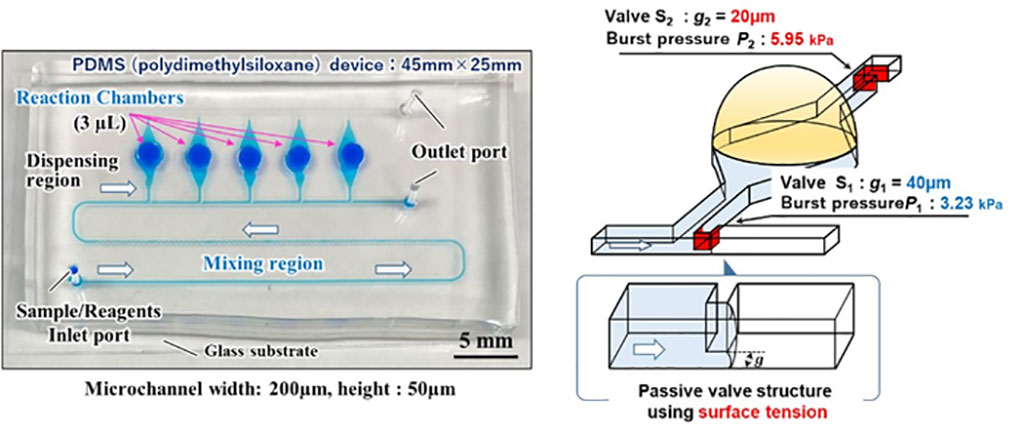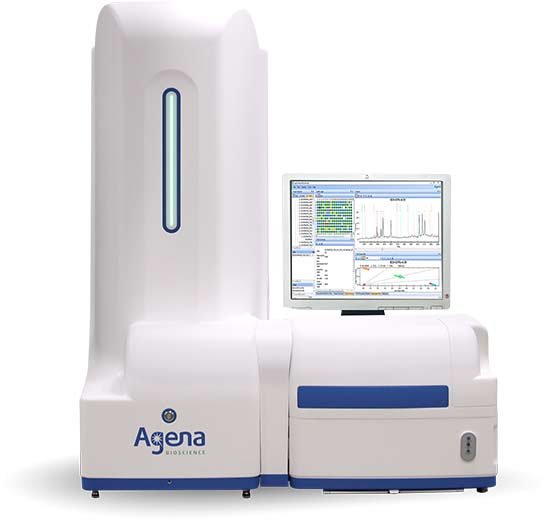Microfluidic Chip Enables Simultaneous Diagnosis of COVID-19 and Influenza Diseases
|
By LabMedica International staff writers Posted on 06 Jan 2022 |

A research team has developed a microfluidic chip that is capable of simultaneous diagnosis of COVID-19 and influenza diseases, by applying the microfluidic chip technologies.
Researchers from the Toyohashi University of Technology (Toyohashi, Japan) and Jikei University School of Medicine (Tokyo, Japan) built a theoretical model that manipulates microfluidic flow with an extremely simple microchannel design and has established an optimal design theory for microfluidic chips. Further, by using the diagnostic device they developed, they performed genetic amplification experiments on four types of infectious diseases, including COVID-19, and demonstrated that multiplexed rapid and simultaneous diagnosis was possible within 30 minutes. The device can be utilized for genetic diagnoses in a range of fields (e.g. agriculture, farming, and fisheries industries, food industry, and health and medical care), not only human infectious diseases. The diagnostic technology can enable anyone, anywhere, any time to detect viral diseases in a rapid, simple, and low-cost way.
The LAMP (Loop-Mediated Isothermal Amplification) method is a genetic test technology. This simple test method does not require an expensive accurate temperature control equipment, etc., in contrast to the widespread PCR test, and can be conducted on site because it allows genetic amplification at a constant temperature for a constant length of time (60 to 65℃, 30 minutes to an hour or so). However, to diagnose multiple types of viruses, the conventional LAMP method entails considerable effort to perform as many preparations of samples and reagents and genetic amplification reactions as the number of analytes, requiring expert knowledge and skills.
Therefore, the research team developed a polydimethylsiloxane (PDMS)-based multiplexed genetic diagnostic device (size: 45mm x 25mm, reaction chamber: 3µL x 5 pieces) by applying the microfluidic chip technology. It autonomously, equally, and accurately dispenses samples and reagent into an array of reaction chambers simply by introducing the liquid, a mixture of an extremely small amount of sample extracted from the analytes and a reagent, into the diagnostic device. By heating the device in warm water (at 60 to 65℃, for 30 minutes to an hour or so), it is capable of simultaneous diagnosis of multiple types of viruses with only one operation (one work process per sample).
The genetic diagnosis result showed that four types of infectious diseases including the COVID-19 (seasonal influenza A, SARS, and influenza H1N1 pdm09) were successfully detected with this diagnosis device. Only the reaction chamber that reacted when a sample containing the gene of each virus was introduced turned sky blue (denoting a positive reaction) after 30 minutes, which means that visual detection is possible.
In addition, to support on-site diagnoses, the team has developed a smartphone app, which automatically diagnoses the reaction as positive or negative based on photographs taken with a smartphone camera. The diagnosis device is capable of easy automatic test result diagnosis (positive or negative), by placing the device after LAMP reaction in a simple LED illumination device and taking photographs with a smartphone. As a result, it is expected that anyone will be able to easily perform the test, anywhere and anytime. In the future, aiming to commercialize the diagnosis device, the research team will develop devices capable of multiplexed rapid diagnosis of variants of the COVID-19 and human infectious diseases for a safe life during and after the COVID-19 pandemic.
Related Links:
Toyohashi University of Technology
Jikei University School of Medicine
Latest COVID-19 News
- New Immunosensor Paves Way to Rapid POC Testing for COVID-19 and Emerging Infectious Diseases
- Long COVID Etiologies Found in Acute Infection Blood Samples
- Novel Device Detects COVID-19 Antibodies in Five Minutes
- CRISPR-Powered COVID-19 Test Detects SARS-CoV-2 in 30 Minutes Using Gene Scissors
- Gut Microbiome Dysbiosis Linked to COVID-19
- Novel SARS CoV-2 Rapid Antigen Test Validated for Diagnostic Accuracy
- New COVID + Flu + R.S.V. Test to Help Prepare for `Tripledemic`
- AI Takes Guesswork Out Of Lateral Flow Testing
- Fastest Ever SARS-CoV-2 Antigen Test Designed for Non-Invasive COVID-19 Testing in Any Setting
- Rapid Antigen Tests Detect Omicron, Delta SARS-CoV-2 Variants
- Health Care Professionals Showed Increased Interest in POC Technologies During Pandemic, Finds Study
- Set Up Reserve Lab Capacity Now for Faster Response to Next Pandemic, Say Researchers
- Blood Test Performed During Initial Infection Predicts Long COVID Risk
- Low-Cost COVID-19 Testing Platform Combines Sensitivity of PCR and Speed of Antigen Tests
- Finger-Prick Blood Test Identifies Immunity to COVID-19
- Quick Test Kit Determines Immunity Against COVID-19 and Its Variants
Channels
Clinical Chemistry
view channel
Blood Test Could Predict and Identify Early Relapses in Myeloma Patients
Multiple myeloma is an incurable cancer of the bone marrow, and while many patients now live for more than a decade after diagnosis, a significant proportion relapse much earlier with poor outcomes.... Read more
Compact Raman Imaging System Detects Subtle Tumor Signals
Accurate cancer diagnosis often depends on labor-intensive tissue staining and expert pathological review, which can delay results and limit access to rapid screening. These conventional methods also make... Read moreMolecular Diagnostics
view channel
AI Tools Detect Early-Stage Cancer Using Simple Blood Test
Early cancer detection remains a major challenge, particularly in low- and middle-income countries, where access to advanced imaging, specialized laboratories, and trained oncologists is limited.... Read more
Sepsis Test Demonstrates Strong Performance in Post-Cardiac Surgery Patients
Sepsis is difficult to diagnose accurately in patients recovering from major surgery, as infection-related symptoms often overlap with non-infectious systemic inflammatory responses. This challenge is... Read moreHematology
view channel
MRD Tests Could Predict Survival in Leukemia Patients
Acute myeloid leukemia is an aggressive blood cancer that disrupts normal blood cell production and often relapses even after intensive treatment. Clinicians currently lack early, reliable markers to predict... Read more
Platelet Activity Blood Test in Middle Age Could Identify Early Alzheimer’s Risk
Early detection of Alzheimer’s disease remains one of the biggest unmet needs in neurology, particularly because the biological changes underlying the disorder begin decades before memory symptoms appear.... Read more
Microvesicles Measurement Could Detect Vascular Injury in Sickle Cell Disease Patients
Assessing disease severity in sickle cell disease (SCD) remains challenging, especially when trying to predict hemolysis, vascular injury, and risk of complications such as vaso-occlusive crises.... Read more
ADLM’s New Coagulation Testing Guidance to Improve Care for Patients on Blood Thinners
Direct oral anticoagulants (DOACs) are one of the most common types of blood thinners. Patients take them to prevent a host of complications that could arise from blood clotting, including stroke, deep... Read moreImmunology
view channel
Ultrasensitive Liquid Biopsy Demonstrates Efficacy in Predicting Immunotherapy Response
Immunotherapy has transformed cancer treatment, but only a small proportion of patients experience lasting benefit, with response rates often remaining between 10% and 20%. Clinicians currently lack reliable... Read more
Blood Test Could Identify Colon Cancer Patients to Benefit from NSAIDs
Colon cancer remains a major cause of cancer-related illness, with many patients facing relapse even after surgery and chemotherapy. Up to 40% of people with stage III disease experience recurrence, highlighting... Read moreMicrobiology
view channel
New UTI Diagnosis Method Delivers Antibiotic Resistance Results 24 Hours Earlier
Urinary tract infections affect around 152 million people every year, making them one of the most common bacterial infections worldwide. In routine medical practice, diagnosis often relies on rapid urine... Read more
Breakthroughs in Microbial Analysis to Enhance Disease Prediction
Microorganisms shape human health, ecosystems, and the planet’s climate, yet identifying them and understanding how they are related remains a major scientific challenge. Even with modern DNA sequencing,... Read morePathology
view channel
AI-Powered Label-Free Optical Imaging Accurately Identifies Thyroid Cancer During Surgery
Thyroid cancer is the most common endocrine cancer, and its rising detection rates have increased the number of patients undergoing surgery. During tumor removal, surgeons often face uncertainty in distinguishing... Read more
Deep Learning–Based Method Improves Cancer Diagnosis
Identifying vascular invasion is critical for determining how aggressive a cancer is, yet doing so reliably can be difficult using standard pathology workflows. Conventional methods require multiple chemical... Read more
ADLM Updates Expert Guidance on Urine Drug Testing for Patients in Emergency Departments
Urine drug testing plays a critical role in the emergency department, particularly for patients presenting with suspected overdose or altered mental status. Accurate and timely results can directly influence... Read moreTechnology
view channel
Pioneering Blood Test Detects Lung Cancer Using Infrared Imaging
Detecting cancer early and tracking how it responds to treatment remains a major challenge, particularly when cancer cells are present in extremely low numbers in the bloodstream. Circulating tumor cells... Read more
AI Predicts Colorectal Cancer Survival Using Clinical and Molecular Features
Colorectal cancer is one of the most common and deadly cancers worldwide, and accurately predicting patient survival remains a major clinical challenge. Traditional prognostic tools often rely on either... Read moreIndustry
view channel
WHX Labs Dubai to Gather Global Experts in Antimicrobial Resistance at Inaugural AMR Leaders’ Summit
World Health Expo (WHX) Labs in Dubai (formerly Medlab Middle East), which will be held at Dubai World Trade Centre from 10-13 February, will address the growing global threat of antimicrobial resistance... Read more























